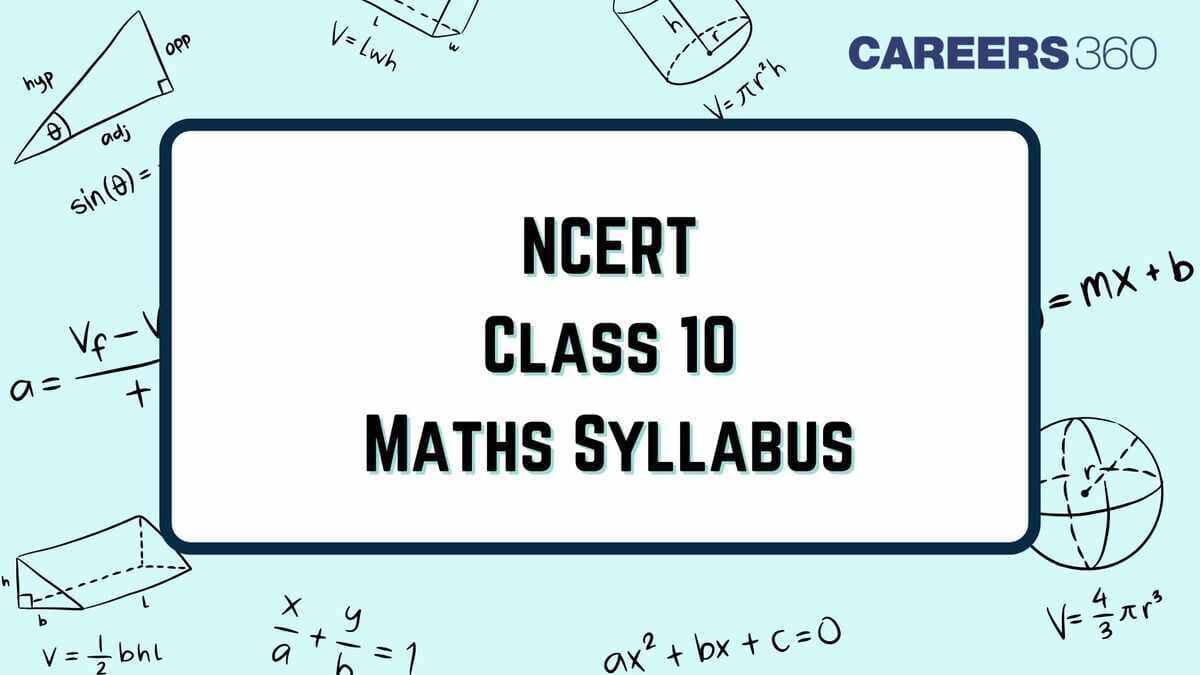Aakash Repeater Courses
ApplyTake Aakash iACST and get instant scholarship on coaching programs.
Dreaming of high marks in Maths? Your Maths success in boards starts with the NCERT Class 10 syllabus. Class 10 is always considered a crucial period in the life of students of any educational board. They will be preparing to appear for their first board examination. In this important phase of their academic career, a proper syllabus will help them plan for their board exam. The NCERT Syllabus for Class 10 Maths 2025-26 introduces students to some key mathematics concepts as well as refreshes the memory of some old concepts. Mastering Real Numbers, Polynomials, Triangles, and Probability in your NCERT syllabus for Class 10 Maths sets the foundation for your future success.

Each chapter you complete in this NCERT syllabus for Class 10 Maths gets you nearer to your dream score. This article provides a chapter-wise, detailed analysis of the NCERT Syllabus for Class 10 Maths 2025-26, helping students and teachers alike prepare for their studies. Faculty of Careers360 prepares this NCERT Syllabus for class 10 in such a way that it can play an important role in developing logical thinking, problem-solving skills, and exam readiness for every student. Students can strengthen concepts by using NCERT books aligned with the latest syllabus.
The Class 10 Maths syllabus 2025-26 NCERT covers 14 chapters. In the table below, students can find the chapters and contents of each chapter.
Chapter Name | Topics |
| 1.1 Introduction |
| 2.1 Introduction |
| 3.1 Introduction |
| 4.1 Introduction |
| 5.1 Introduction |
| 6.1 Introduction |
| 7.1 Introduction |
| 8.1 Introduction |
| 9.1 Heights and Distances |
| 10.1 Introduction |
| 11.1 Areas of Sector and Segment of a Circle |
| 12.1 Introduction |
| 13.1 Introduction |
| 14.1 Probability — A Theoretical Approach |
Below is the unit-wise division of the NCERT Maths class 10 syllabus. This unit-wise division will be beneficial for the students to divide the NCERT syllabus for class 10 Maths into smaller chunks and prepare efficiently by creating a timetable. Also, our experienced faculty at Careers360 has given expected marks from each unit after extensive research of previous year's question patterns.
Click the link below to download the NCERT syllabus for Class 10 Maths easily. Careers360 has prepared this handy PDF so you can study anytime, anywhere.
Download NCERT syllabus for class 10 Maths 2025-26 PDF
The NCERT Class 10 Maths exam has 100 full marks, divided into two parts.
Based on the previous years' papers, the Careers360 faculty has prepared the table below to explain the types of questions in each section and their respective marks. Students will get 3 hours during the exam to complete this part.
The internal assessment part is of 20 marks.
It consists of:
For your upcoming first board examination, you should completely solve the NCERT maths books for class 10. Only after that, you should try solving the reference books as suggested by the board toppers and maths experts. While choosing the reference books, you should keep in mind a few points like the book should contain a good number of solved examples as well as unsolved exercises, the language should be easy to understand, it should contain all types of questions asked in the exam, etc.
Here is a list of some of the best reference books that can help to score well in the exam:
Also check: NCERT books for Class 10 for all Subjects
Candidates should equally prioritise the syllabus of other subjects equal to the syllabus of Maths in class 10. We, at Careers360, provide the comprehensive syllabus of the other subjects below for reference by all 10th-grade students using the NCERT books.
The important topics covered in NCERT Class 10 Maths syllabus, which are important in the board exam, are:
There are a total of 14 chapters in the Class 10 Maths NCERT book. These chapters are segregated into 7 units.
Yes, for the 2025-26 session, NCERT is introducing new textbooks and syllabus updates for Classes 4, 5, 7, and 8. But the expectation for the Class 10 Maths syllabus is that this year it will be same as previous year.
Hardness of the chapter depends mainly on students' preparation, strengths and weaknesses. Here are some chapters which require more attention than other chapters.
Yes, NCERT Maths Class 10 Syllabus includes the concept of Coordinate Geometry in Unit III. It is one of the important chapters including topics like distance formula and section formula.

Take Aakash iACST and get instant scholarship on coaching programs.

This ebook serves as a valuable study guide for NEET 2025 exam.

This e-book offers NEET PYQ and serves as an indispensable NEET study material.

As per latest syllabus. Physics formulas, equations, & laws of class 11 & 12th chapters
As per latest syllabus. Chemistry formulas, equations, & laws of class 11 & 12th chapters
As per latest 2024 syllabus. Study 40% syllabus and score upto 100% marks in JEE